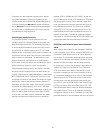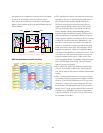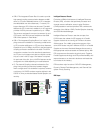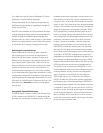35
Customers who are interested in testing and/or deploy-
ing System-Managed CF Structure Duplexing in their
sysplex should review GM13-0103,
System-Managed CF
Structure Duplexing
at ibm.com/server/eserver/zseries/
pso or
ibm.com/server/eserver/zseries/library/techpapers/
gm130103.html to understand the performance and other
considerations of using this feature.
Parallel Sysplex Coupling Connectivity
The Coupling Facilities communicate with z/OS and
OS/390 images in the Parallel Sysplex environment over
specialized high-speed links. For availability purposes, it
is recommended that there be at least two links connect-
ing each z/OS or OS/390 image to each CF in a Parallel
Sysplex cluster. As processor performance increases, it is
important to also use faster links so that link performance
does not become constrained. The performance, avail-
ability and distance requirements of a Parallel Sysplex
environment are the key factors that will identify the appro-
priate connectivity option for a given confi guration.
Parallel Sysplex coupling links on the zSeries have been
enhanced with the introduction of Peer Mode. When con-
necting a zSeries server (z990/z900/z800) to a z800 Model
0CF, a z900 Model 100 or a zSeries ICF, the links can be
confi gured to operate in Peer Mode. This allows for higher
data transfer rates to and from the Coupling Facilities. In
Peer Mode, the fi ber-optic single mode coupling link (ISC-
3) provides 200 Gbps capacity, up to 10 km, 100 Gbps
up to 20 km, the ICB-3 link with 1 GBps peak capacity, the
ICB-4 for z990 to z990 connection at 2.0 GBps, and the
IC-3 link with 1.25 GBps capacity. Additional Peer Mode
benefi ts are obtained by enabling the link to be MIFed
between z/OS (or OS/390) and CF LPARs. The peer link
acts simultaneously as both a CF Sender and CF Receiver
link, reducing the number of links required. Larger and
more data buffers and improved protocols also improve
long distance performance. For connectivity to 9672s,
zSeries ISC-3 CF links can be confi gured to run in Com-
patibility Mode with the same characteristics as links on
the 9672 of 100 Gbps. The z900 and z990 also support
ICB-2 links for connectivity to 9672s. The ICB coupling link
speeds described above are theoretical maximums.
GDPS/PPRC Cross Site Parallel Sysplex distance Extended to
100 km
When using a Dense Wave Division Multiplexor (DWDM),
it will be possible via an RPQ to confi gure GDPS/PPRC or
a multi-site Parallel Sysplex with up to 100 km between
the two sites. The immediate advantage of this extended
distance is to potentially decrease the risk that the same
disaster will effect both sites, thus providing the ability
for customers to recover their production applications at
another site. Support for the External Timer Reference
(ETR) links and the Inter System Channel (ISC-3) links
has been increased from the current capability of 50 km
to an extended capability of up to 100 km. The extended
distance support for ETR and ISC-3 links is now consis-
tent with other cross site technologies that already sup-
port 100 km, such as FICON, Peer-to-Peer Remote Copy
(PPRC), and Peer-to-Peer Virtual Tape Server (PtP VTS).
It should be noted that the maximum distance between a
pair of 9037 Sysplex Timers in an Expanded Availability
confi guration remains at 40 km. Therefore, to achieve the
extended distance of 100 km between the two sites, one of


















